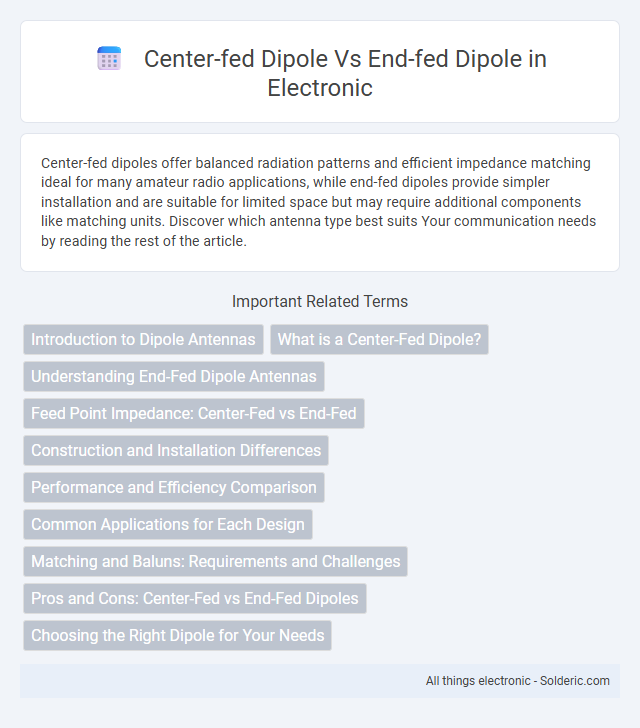Center-fed dipoles offer balanced radiation patterns and efficient impedance matching ideal for many amateur radio applications, while end-fed dipoles provide simpler installation and are suitable for limited space but may require additional components like matching units. Discover which antenna type best suits Your communication needs by reading the rest of the article.
Comparison Table
| Feature | Center-Fed Dipole | End-Fed Dipole |
|---|---|---|
| Feed Point | Center of the antenna | One end of the antenna |
| Impedance | Typically 50-75 ohms | High impedance, often requires matching network |
| Feeding Complexity | Simple coaxial feed with balun | Requires impedance transformer or tuner |
| Radiation Pattern | Symmetrical, broadside maximum radiation | Asymmetrical, may have stronger end-fire lobes |
| Installation | Requires center support | Can be supported from one end |
| Bandwidth | Generally wider bandwidth | Narrower bandwidth without tuning |
| Common Use | Amateur HF bands, VHF/UHF | Portable, restricted space installations |
Introduction to Dipole Antennas
Center-fed dipole antennas feature a symmetrical structure with the feed point at the center, providing balanced impedance and efficient radiation patterns ideal for HF and VHF communications. End-fed dipole antennas have the feed point at one end, often requiring impedance matching devices like transformers or tuners to achieve effective power transfer. Both types are fundamental dipole configurations used extensively in amateur radio, offering distinct installation flexibility and feeding requirements depending on operational scenarios.
What is a Center-Fed Dipole?
A center-fed dipole is a type of antenna where the feedline connects at the geometric center, ensuring balanced current distribution along its two equal-length conductive elements. This configuration provides low feed-point impedance, typically around 50 to 75 ohms, making it compatible with standard coaxial cables and minimizing signal loss. Its symmetrical design enhances radiation efficiency and broad frequency resonance, making it a preferred choice for amateur radio and HF communications.
Understanding End-Fed Dipole Antennas
End-fed dipole antennas offer a convenient installation by requiring only a single feed point, making them ideal for limited space or portable setups. Unlike center-fed dipoles, end-fed antennas typically need an impedance matching device, such as an unun, to ensure efficient power transfer and minimize signal loss. You can benefit from their simplicity and compactness, but understanding their feed impedance and potential for RF interference is crucial for optimal performance.
Feed Point Impedance: Center-Fed vs End-Fed
Center-fed dipoles typically exhibit a feed point impedance around 50 to 75 ohms, making them compatible with standard coaxial cables and simplifying impedance matching. End-fed dipoles, in contrast, present a much higher impedance, often ranging from several hundred to a few thousand ohms, necessitating the use of impedance matching devices such as transformers or antenna tuners. Understanding these impedance characteristics is crucial for optimizing antenna performance and ensuring efficient power transfer between the transmitter and the antenna system.
Construction and Installation Differences
A center-fed dipole consists of two equal-length conductive elements connected at the center with the feedline, requiring a symmetrical mounting structure, often elevated and insulated from ground. An end-fed dipole features a single feedpoint at one end, simplifying installation by needing only one support and often incorporating a matching network or counterpoise to manage impedance. Center-fed dipoles typically demand more precise installation to maintain balance, while end-fed dipoles offer greater flexibility but can introduce increased feedline losses without proper impedance matching.
Performance and Efficiency Comparison
Center-fed dipoles typically offer higher performance and efficiency due to their symmetrical feeding, which ensures balanced current distribution and low feedline losses. End-fed dipoles often exhibit higher feedpoint impedance and can be less efficient because of unbalanced currents and increased radiation resistance. Your choice affects antenna tuning and overall signal quality, with center-fed designs generally providing more consistent and reliable operation.
Common Applications for Each Design
Center-fed dipoles are commonly used in amateur radio and shortwave listening due to their balanced feed, making them ideal for HF bands and multiband operation with an antenna tuner. End-fed dipoles are popular for portable, covert, or limited-space installations because they require only a single feed point and minimal ground system, often preferred for vertical or sloper configurations in field operations. Both designs are widely employed in antenna experimentation, but center-fed dipoles dominate fixed installations, while end-fed dipoles excel in flexible, temporary setups.
Matching and Baluns: Requirements and Challenges
Center-fed dipoles typically require a balanced feed line and often use a 1:1 balun to ensure impedance matching and minimize feed line radiation, enhancing signal integrity. End-fed dipoles present more complex matching challenges due to their high impedance at the feed point, frequently necessitating impedance transformers or unun baluns to achieve proper matching and efficient power transfer. Balun selection and placement are critical to prevent common-mode currents and maintain antenna performance for both center-fed and end-fed configurations.
Pros and Cons: Center-Fed vs End-Fed Dipoles
Center-fed dipoles offer balanced feed points that reduce common-mode currents and provide better impedance matching, resulting in improved transmission efficiency and lower signal loss. End-fed dipoles simplify installation by requiring only one support point, but they often need a matching network or transformer to handle high feed-point impedance, which can introduce losses and increase complexity. While center-fed dipoles are preferred for stable performance in controlled environments, end-fed dipoles excel in portable or restricted spaces despite potential compromises in feedline noise and tuning.
Choosing the Right Dipole for Your Needs
Choosing the right dipole antenna depends on your installation space and signal goals; center-fed dipoles offer balanced feed and often provide better impedance matching for efficient transmission. End-fed dipoles require less coaxial cable and simpler setup, making them ideal for limited space or portable operations despite potential need for an unun transformer. Evaluate your available location, equipment compatibility, and desired frequency range to ensure your antenna choice maximizes performance and communication quality.
center-fed dipole vs end-fed dipole Infographic

 solderic.com
solderic.com